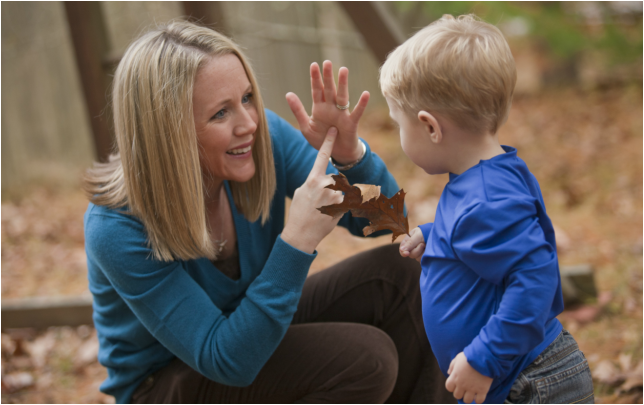American Sign Language Can Benefit All Children
as They Develop Social and Learning Skills
As signing becomes more mainstream with hearing parents and their babies, to aid early communication and greatly reduce frustration, why stop signing once your little one can speak fluently? There are many benefits for continuing to sign into the toddler, preschool and elementary years...and beyond! When you choose to teach your baby American Sign Language (ASL) vocabulary to help your little one express basic needs and wants, you’re laying the foundation of learning a legitimate second language – the third most commonly used language in the United States. By the time many little ones are off to preschool or elementary school, they’ll likely encounter other children who use ASL as their main mode of communication. Continuing with ASL signs teaches a sensitivity for the 20 million people in North America who rely on the language as their main means of communication.
Signing is a wonderful tool in the toddler years at home, in preschool and in public when used to remind little ones of expectations for appropriate behavior. Adults can clearly, discreetly, and effectively use signs to remind little ones to use their manners or to interact appropriately with peers, without drawing attention to these all important reminders and redirections toward more positive behavior. Signing is also a great way for upset, crying, frustrated and shy children to express their emotions in a positive manner without acting out. Sometimes a little one is too upset to speak but their feelings and needs are literally at their fingertips.
Signing at any age enhances fine and gross motor skills and engages the brain in a unique way, creating connections between the right and left hemispheres that only exist when children see and use sign language. Right and left brain coordination is necessary for crawling, walking and eventually reading. Children begin learning the moment they enter the world but it will be years before they show dominance as a visual learner, an auditory learner or a kinesthetic/hands-on learner. Signing and speaking with hearing children affords them the opportunity to receive and express communication in multiple modalities, addressing all learning styles simultaneously. Signing can easily be integrated with a cross-curricular approach with ASL signs being introduced in fun ways across all subjects. Nancy Hanauer of Hop to Signaroo ® has created a fun, inventive, cross-curricular approach to weaving ASL signs into all subject areas and in daily routines with a special emphasis on integration through favorite storybooks, songs, art and movement for preschool and elementary students.
Finally, American Sign Language is offered in most states as a foreign language option in high school and college. ASL syntax has a structure all it’s own, but most teen and adult learners find learning ASL to be much easier than learning a second spoken language. Laying that bilingual foundation and an appreciation for ASL early on can not only have long-term linguistic and brain development benefits and bridge the gap between the hearing and deaf communities, but may spark an interest in this beautiful language for further study in the future. Learn more at www.hoptosignaroo.com/about/benefits.htm
by Nancy Hanauer, Founder of Hop to Signaroo ®
Signing is a wonderful tool in the toddler years at home, in preschool and in public when used to remind little ones of expectations for appropriate behavior. Adults can clearly, discreetly, and effectively use signs to remind little ones to use their manners or to interact appropriately with peers, without drawing attention to these all important reminders and redirections toward more positive behavior. Signing is also a great way for upset, crying, frustrated and shy children to express their emotions in a positive manner without acting out. Sometimes a little one is too upset to speak but their feelings and needs are literally at their fingertips.
Signing at any age enhances fine and gross motor skills and engages the brain in a unique way, creating connections between the right and left hemispheres that only exist when children see and use sign language. Right and left brain coordination is necessary for crawling, walking and eventually reading. Children begin learning the moment they enter the world but it will be years before they show dominance as a visual learner, an auditory learner or a kinesthetic/hands-on learner. Signing and speaking with hearing children affords them the opportunity to receive and express communication in multiple modalities, addressing all learning styles simultaneously. Signing can easily be integrated with a cross-curricular approach with ASL signs being introduced in fun ways across all subjects. Nancy Hanauer of Hop to Signaroo ® has created a fun, inventive, cross-curricular approach to weaving ASL signs into all subject areas and in daily routines with a special emphasis on integration through favorite storybooks, songs, art and movement for preschool and elementary students.
Finally, American Sign Language is offered in most states as a foreign language option in high school and college. ASL syntax has a structure all it’s own, but most teen and adult learners find learning ASL to be much easier than learning a second spoken language. Laying that bilingual foundation and an appreciation for ASL early on can not only have long-term linguistic and brain development benefits and bridge the gap between the hearing and deaf communities, but may spark an interest in this beautiful language for further study in the future. Learn more at www.hoptosignaroo.com/about/benefits.htm
by Nancy Hanauer, Founder of Hop to Signaroo ®
Learn more about ASL from Nancy Hanauer, Founder of Hop to Signaroo ®
Nancy Hanauer, Founder of Hop to Signaroo ® | Preverbal Babies Can Communicate with ASL
Nancy Hanauer, Founder of Hop to Signaroo ® | Preverbal Babies Can Communicate with ASL

